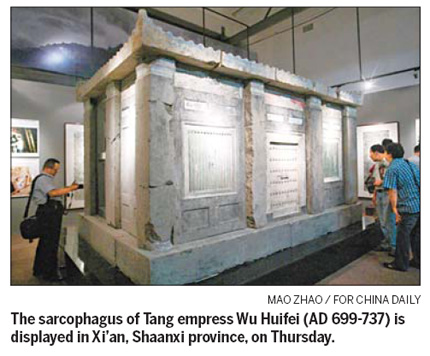Stone coffin of Tang Dynasty brought back home

The return of a smuggled Tang Dynasty (618 - 907) sarcophagus from the United States to China may serve as a good example for international collaboration to curb the rampant pillaging and smuggling of ancient treasures, researchers said.
The 27-tonne stone coffin of Tang empress Wu Huifei (699-737) arrived at the Shaanxi History Museum Thursday, four years after it was smuggled out of the country.
The sarcophagus is 4 meters long, 2 meters wide and 2 meters high. It features flowers and maiden figures in relief. Robbers stole it from Wu's tomb in the southern suburbs of Xi'an, capital of Shaanxi Province, in 2006.
"It is a rare cultural relic with high scientific, historical and artistic value," Friday's China Daily quoted Liu Daiyun, director of the research department of the Shaanxi provincial archaeological research institute, as saying.
Xi'an police found out about the sarcophagus in February 2006 during an investigation over a tomb robbery. They seized a computer containing a number of its pictures in a suspect's house and local archaeologists soon identified the relic's origin.
After two years of investigations, police discovered the sarcophagus had been smuggled out of China and sold to a businessman in the United States for 1 million U.S. dollars, police sources said.
"We contacted the businessman through mediators and told him we had to get the relic back. If necessary, we would seek help from Interpol," said Han Yulin, head officer of the heritage investigation team of Xi'an's public security bureau.
"After three rounds of negotiations, he agreed to return the relic to China unconditionally."
The sarcophagus was shipped back from Virginia March 16 and arrived in Guangzhou, capital of Guangdong Province, on April 17.

